Join More Than 50,000+ Subscribers and get latest camera news and rumors
NEW CAMERA VIDEOS ON YOUTUBE
|
By admin, on July 24th, 2015
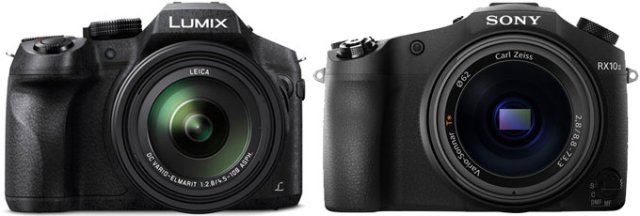 The FZ300 is recently announced by Panasonic, the camera features advance core specification but the only problem is the small sensor inside it, on the other hand Sony RX10 II features large 1″ sensor…. Take a look at the specification comparison review between the Sony RX10 II and FZ300 camera, The FZ300 is recently announced by Panasonic, the camera features advance core specification but the only problem is the small sensor inside it, on the other hand Sony RX10 II features large 1″ sensor…. Take a look at the specification comparison review between the Sony RX10 II and FZ300 camera,
Major Difference
Panasonic Lumix DMC-FZ300 vs. Sony Cyber-shot DSC-RX10 II Specification Comparison Table.
| Features / Models |
Panasonic FZ300 |
Sony RX10 II |
| Megapixel |
12 megapixels |
20 megapixels |
| Sensor size / type |
1/2.3″ (6.17 x 4.55 mm) |
1″ (13.2 x 8.8 mm) |
| Low –Pass filter |
Yes |
Yes |
| Optical zoom |
24x |
8.3x |
| Aperture Range |
F2.8 |
F2.8 |
| Macro |
1cm |
3cm |
| Image stabilization |
5-axis hybrid IS |
Optical |
| AF System |
Contrast Detect (sensor) |
Contrast Detect (sensor) |
| ISO |
100-6400 |
64-25600 |
| Shutter Min/Max |
60 sec 1/16000 sec |
30 sec 1/32000 sec |
| Top Continuous Shooting Speed |
12fps |
14fps |
| Video |
3840 x 2160 (30p, 24p) |
3840 x 2160 (30p, 25p, 24p) |
| Display |
3.0″ LCD Rear Touch Screen Swivel (1,040,000 pixels) |
3.0″ LCD Rear Screen Tilt (1,229,000 pixels) |
| Viewfinder |
EVF |
EVF |
| Hot-shoe |
Yes |
Yes |
| Battery Life (CIPA) |
380 shots |
400 shots |
| Environmentally sealed |
Yes |
Yes |
| Wireless connectivity |
Built-In |
Built-In with NFC |
| Dimensions |
132 x 92 x 117 mm |
129 x 88 x 102 mm |
| Weight |
691g |
813g |
Sensors: Sony DSC RX10 II has 20.2 MP 1″ Exmor RS BSI CMOS Sensor which is based on backside-illuminated technology. While the FZ300 supports 12MP 1/2.3″ high-Sensitivity MOS sensor added with the Venus Engine image processor.
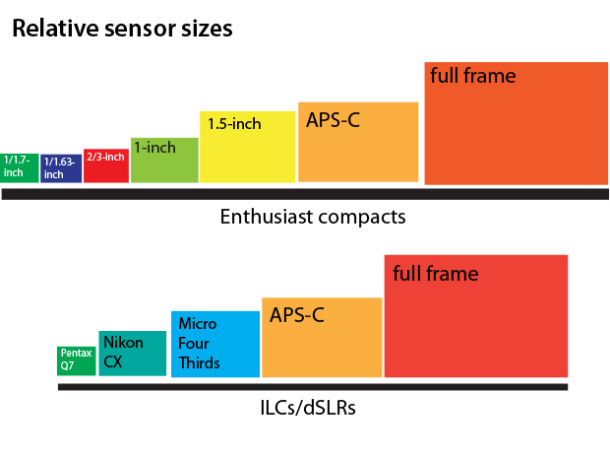 Hence the sensor of RX10 II is larger and superior to FZ300. The large sensor inside the RX10 II definitely improves the clarity and image as well its performance in low-light condition. Sony RX10 II has two stop more ISO compare to FZ300 , which makes it more sensitive to low-light environment and hence it captures correctly exposed image even at low-light condition when compared to FZ300. Hence the sensor of RX10 II is larger and superior to FZ300. The large sensor inside the RX10 II definitely improves the clarity and image as well its performance in low-light condition. Sony RX10 II has two stop more ISO compare to FZ300 , which makes it more sensitive to low-light environment and hence it captures correctly exposed image even at low-light condition when compared to FZ300.
Sony RX10 II has the integrated DRAM chip into the sensor and its combination with the BINOZ X processor supports 4K recording upto 30 mins and can capture 20MP files @14fps on the other side FZ300 has the capacity to capture 12MP files @12fps., the Sony RX10 II is really have uncomparable speed.
Sony RX10II sensor will give you better image quality compared to FZ300.
Optical Zoom: FZ300 uses the Leica DC Vario-Elmarit 24x Zoom Lens which supports the equivalent focal length of 25-600mm and also supports maximum and fixed aperture of f/2.8. While Sony RX10 II has uses the Carl Zeiss Vario-Sonnar T* 8.3x Optical Zoom Lens with fixed F2.8 aperture range, the biggest reason behind the coverage of more optical zoom by Panasonic is its small sensor size. However if you want a zoom camera you may go with Nikon P900 that features 83X optical zoom.
Yes the Panasonic FZ300 more zoom compared to RX10 II.
Image Stabilization: Panasonic FZ300 used the advanced 5-Axis HYBRID Optical Image Stabilization on the other hand the camera Sony RX10 features 3 way image stabilization. The Optical image stabilization used in FZ300 reduces the production of blur due to your shaky hands and also it corrects five types of camera shake during handheld shooting. It also compensates in real time vibration while recording the still or the action videos while walking. Whereas RX10 II has the Optical SteadyShot image stabilization and reduce the camera shake works dim-light conditions. Its Active 3-Way stabilization maintains the balance between both clockwise and counter-clockwise movements while recording videos.
FZ300 has used the advanced Image stabilization compare to RX10 II.
Shutter Speed: Both Sony and Panasonic camera features built in electronic as well as mechanical shutter, however the RX10 II electronic shutter limit goes upto 1/32000, which is far better than FZ300 on the other hand the FZ300 long exposure mode is better compared to RX10 II.
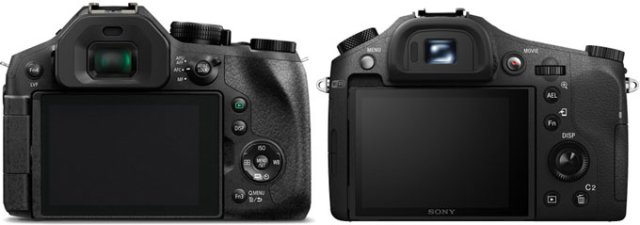
Video: The FZ300 supports recording 4K UHD at the resolution of 3840 x 2160pixels video with either 30p or 24p frames rates at 100 Mbps in the MP4 format. Also RX10 II supports 4K UHD video recording and also offers shooting up to 100 Mbps. The biggest advantage of RX10 II is super slow motion recording,it can record super slow-motion full HD video up to 960 fps.
Display: In Sony RX10 II 3.0″ 1228K-dot LCD monitor is integrated into the camera body and features a tilting design to promote easier use from high and low angles, on the other hand the Panasonic FZ300 have bit low resolution vari-angle touch display unit.
Price Difference: A big price difference present, The Panasonic FZ300 will cost your approx $700 less compared to the RX10 II.
Verdict: We highly recommend you to buy Sony RX10 II if Price doesn’t matter.
Buy Sony RX10 II from Amazon | B&H
By abhishek, on June 22nd, 2015
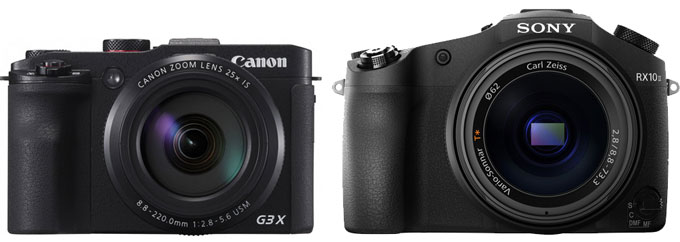
We are doing a specification comparison here take a look at the major difference between both the camera…
Major Difference
Canon PowerShot G3 X vs. Sony Cyber-shot DSC-RX10 II Specification Comparison Table.
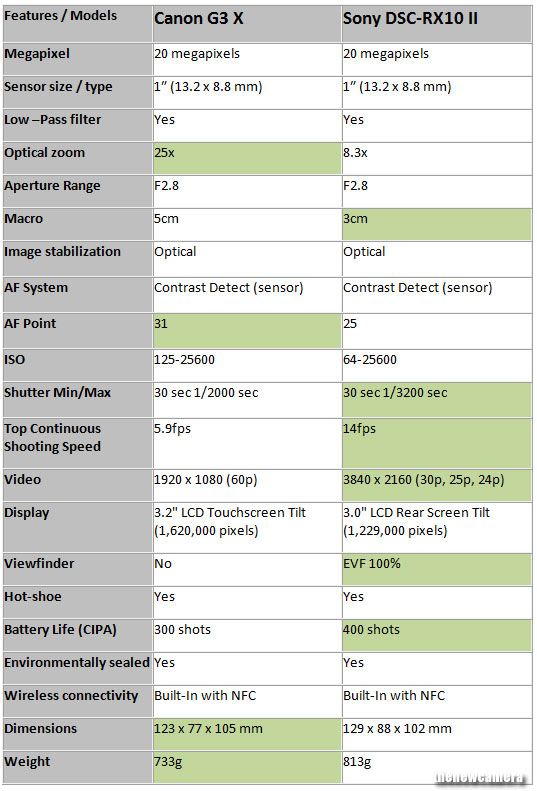 Sensor: Both the camera features almost same sensor and same resolution but the technologies inside the sensor is different, the Sony RX10 uses Exmor RS BSI CMOS sensor and on the other hand the Canon uses CMOS sensor (of RX100 M3 camera). Sensor: Both the camera features almost same sensor and same resolution but the technologies inside the sensor is different, the Sony RX10 uses Exmor RS BSI CMOS sensor and on the other hand the Canon uses CMOS sensor (of RX100 M3 camera).
with the help a new sensor’s design that utilizes a stacked CMOS image sensor with a DRAM chip and backside-illuminated technology, the RX10 will sure give you neat image (without noise at higher ISO settings).
Lens: The Canon G3X have 25X Optical zoom and RX10 is limited to 8.3X optical zoom only, the major advtange of the RX10 camera is constant aperture range of the camera, the RX10 offers you fixed F2.8 aperture throught the zoom range on the other hand the Canon 25X optical zoom lens have variable aperture starting from 2.8-5.6, the constant aperture will sure give you more DOF in RX10 images when used at longer focal length compared to Canon.
The Sony RX10 features better close-up range compared to the Canon G3X (5cm vs 3cm), a better macro mode allow you to go more closer to the subject with losing the focus of the camera.
Auto focus system: Both the camera features same contrast based AF system, however the Canon have more dense AF points compared to Sony.
Continuous shooting speed: Despite of having same resolution as of G3X camera the Sony RX10 features blazing fast continuous shooting speed of 14fps on the other hand the Canon G3X camera is limited to 5.5fps only,
Thanks to the introduction of DRAM chip is integrated into the sensor, and combined with the BINOZ X processor, it allows for fast readout speeds directly from the sensor, with the help of the new technology the burst shooting touched a new height of up to 14 fps, and now you can use maximum physical shutter speed of 1/3200 sec and a maximum electronic shutter speed of 1/32000 sec.
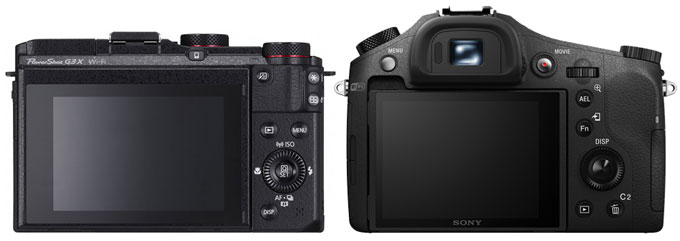 The Sony RX10 gives a prefect place for thumb-grip and button layout are more perfectly designed compared to Canon, the other major advantage is the presence of XGA OLED Electronic Viewfinder on the rear side of the camera. 4K Video: The RX10 can shoot 4K (30/24fps) videos Up to 29 Minutes, the Canon G3X is limited to Full HD (60p) video mode only… while recording the videos you can use the full optical zoom and fulltime AF support of both the camera.
Verdict: From specification comparison review it is very clear that Canon G3X is offering us more optical zoom lens on the other hand the Sony RX10 II features bright optical zoom lens with F2.8 aperture, that will give us better color and contrast with more DOF when used at longer focal length, the camera also features newly developed DRAM memory (buffer) Chip on the rear side of the sensor to increase the data transfer speed exponentially that help to to achieve continuous shooting speed of 15fps and also able capture 4K without an issue.
We highly recommend you to go with Sony RX10 II, It’s and all-rounder camera and recommend for still and video shooters and if you are a still shooter and need more zoom lens and DOF / continuous shooting speed isn’t a issue for than you should go with Canon G3X
Buy Canon G3X from Amazon | B&H
Buy Sony RX10 II from Amazon | B&H
By abhishek, on June 20th, 2015
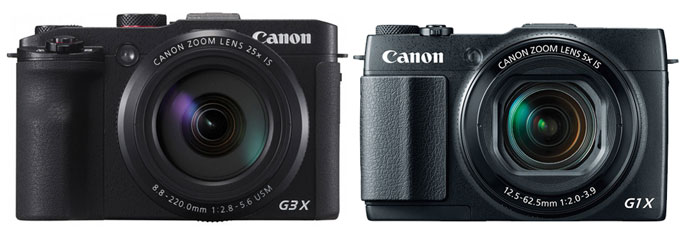 Which camera should you buy, newly announced Canon G3X camera or Canon G1X Mark II camera, take a look at the detailed specification comparison review below and share your thoughts with us…. Which camera should you buy, newly announced Canon G3X camera or Canon G1X Mark II camera, take a look at the detailed specification comparison review below and share your thoughts with us….
Major Difference
Canon PowerShot G3 X vs. Canon PowerShot G1 X Mark II Specification Comparison Table.
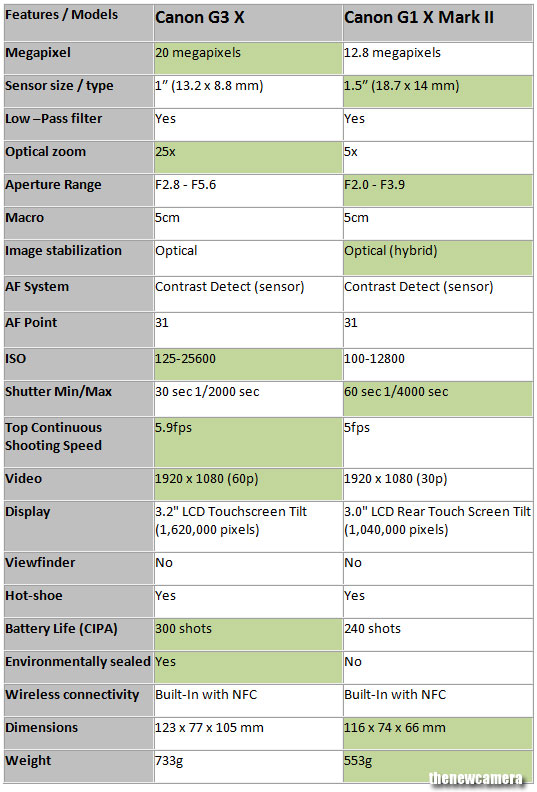
Sensor: The canon GX3 X camera features 20 MP 1″ sensor and the Canon G1X Mark II features 12 MP 1.5″ sensor, that clearly means that the photo diodes of the Canon G1X Mark II are big compared to the Canon G3X camera, large photodiodes collects more light and in-return you get better low-light images.
But both the sensors are bit different, the Canon G1X Mark II camera is build by Canon itself and Canon G3X sensor is developed by Sony, (same sensor as of RX100 M3).
Lens: The Canon G3X features a 25X optical zoom lens on the other hand the Canon G1X Mk II limited to 5X optical zoom lens only, the other noticeable difference is the aperture range of both the camera, the Canon G1X Mark II features bright optical zoom lens F2.0 – F3.9 on the other hand the ISO range of the G3X is limited to F2.8-F5.9, however we have to keep in mind the G3X has more lens elements inside it compared to the Canon G1X MK II camera.
More ISO Range – Despite of having small sensor and more resolution the Canon G3X offers more ISO range, so we do expect that Canon G3X will perform better under low-light condition. However we will publish high ISO test images of both the camera as soon as they became available.
Both camera features Hybrid image stabilization, the system selects from Normal IS, Panning IS, Macro (Hybrid) IS and Tripod modes. When shooting video, the system selects from Dynamic IS, Powered IS, Macro (Hybrid) IS and Active Tripod IS modes.
Auto-focus system – Both the compact camera features same type of contrast based AF system with 31 AF points.
Fast Continuous shooting speed in G3X – The Canon G3X not only features more resolution but it also features bit more continuous shooting speed. So if you are a sports shooter and need a compact camera than for sure the Canon G3X is best for you since it offers you more optical zoom, ISO range and burst rate.

Canon G3X can shoot Full HD Video @ 60fps on the other hand the Canon G1X Mark II camera is limited to 30fps only while recording the video, the optical zoom will sure help you to get closer to
Dust- and water-resistant – Canon G3X is the first Canon G Series compact camera to feature weather resistance sealing, the camera G1X Mk II doesn’t have such type of sealing. The weather sealing let you free to use your compact without worrying about outdoor weather condition.
Verdict: I will pick Canon G3X as clear winner, since the camera features more optical zoom, more ISO range and and bit fast continuous shooting speed… we highly recommend you to buy Canon G3X camera.
Buy Canon G3X from Amazon | B&H
By abhishek, on May 22nd, 2015
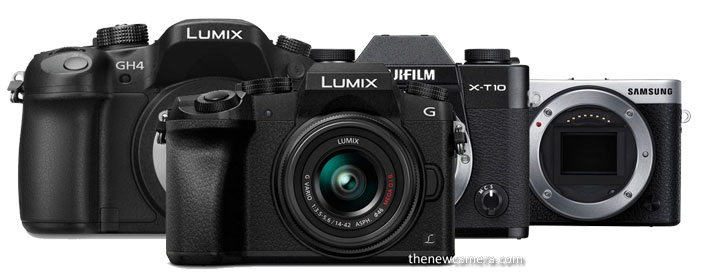 We have done a specification comparison review among the three entry level camera and one high-end camera, Jump to Verdict at the end for quick answer to your question… We have done a specification comparison review among the three entry level camera and one high-end camera, Jump to Verdict at the end for quick answer to your question…
The Panasonic G7 is just announced by the Panasonic, G7 is a entry level mirrorless camera with 4K video recording, the camera not only records 4K video but also captures 16 Megapixel Still from a 4/3 sensor.
However if we look at all the camera below in the table we can clearly see that the Samsung NX500 is a complete technology breakthrough if we compare its price with features…
Sensor – Panasonic cameras get a early defeat due to the small sensor size used inside the camera, now only two camera left with big sensor,.. the NX500 and X-T10.
As we know that bigger sensor captures more light, other major factor is number of pixels vs sensor size… if the pixel density is high than each pixels will get small fraction of light compared to sensor with larger pixels, the fujifilm X-T10 sensor is of same size as of the Samsung NX500 and due to less resolution the pixels are big and will capture more light compared to the Samsung NX500… hence FUji X-T10 will give you better low light performance compared to the Samsung NX 500.
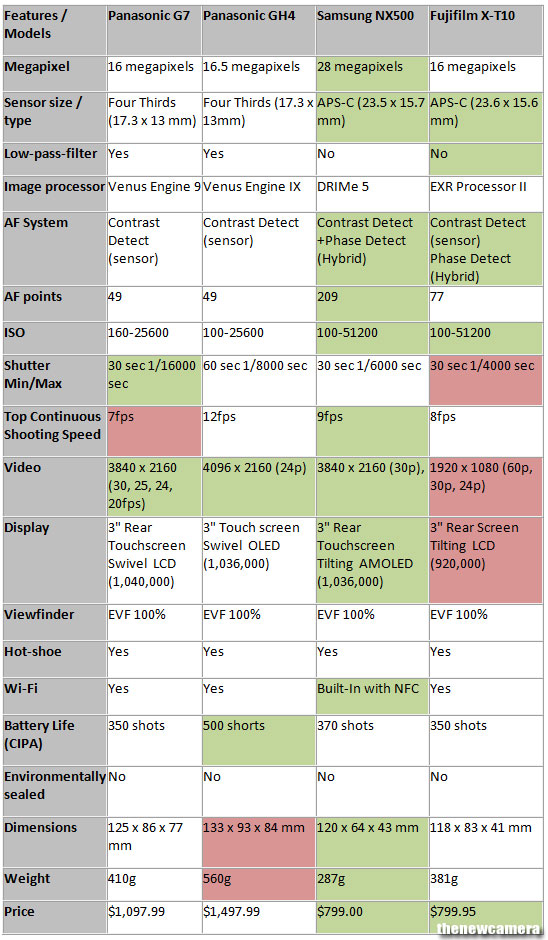
Advance AF system inside the Samsung and Fuji – Samsung NX500 and Fuji X-T10 both camera based on advance Hybrid CMOS AF sensor technology,
1. NX500 features a dense network of 209 active phase AF points inside the sensor.. not only that thanks to the ultra fast image processor the camera can do shoot 9frames per second @ 28 Megapixels…
“High-speed shooting at up to 9 fps is possible as well and the NX500 uses the NX Autofocus System III with 205 phase-detect points of which 153 are cross-type for fast, accurate focusing.”
2. X-T10 features X-trans sensor that also feature 77 active phase AF points inside the sensor… and captures
” Fujifilm’s unique X-Trans pixel array, the sensor is designed with a randomized pixel pattern to eliminate the need of an optical low-pass filter for reducing moiré and aliasing. By removing this filter from the design, higher image sharpness is possible. “
3. The Panasonic uses traditional contrast based Auto focus system.. but thanks to the new DFD system the AF system do work very well under any light condition…
The high-precision Contrast AF integrates DFD (Depth from Defocus) technology to achieve AF speeds of approximately 0.07 sec in AFS mode.
High ISO Performance
As we have said earlier … The camera sensor size is very important when low-light performance matters, the bigger the sensor will capture more low-light compared to the smaller ones…
Panasonic G7 and Panasonic GH4 sensor size is limited (17.13mm) and the ISO range is limited upto 25600, on the other hand the Samsung NX500 and Fujifilm XT-10 both features APS-C sensor and ISO range upto 51200.
Despite of having such a High ISO range we won’t get better performance from Samsung NX500 since the size of the pixels are smaller compared to the X-T1 camera… so if you are a low light lover you mist go with the X-T10 camera.
Shutter:
Both Panasonic G7 and GH4 features electronic and mechanical shutter..The widest shutter range is of Panasonic G7. Both camera have silent shutter feature inside, when you select silent shutter mode the cameras work in silent mode without making a noise.
Samsung NX500 and Fuji X-T10 also have electronic and mechanical shutter, but no silent shutter option available in the Samsung NX500 as of Panasic GH4 and G7.
Video: Out of all these 4 mirrorless camera three of them shoot 4K videos, the Fuji X-T10 is only limited to Full HD video.
The Panasonic G7 records 4 K videos internally and G7 supports 4K UHD (3840 x 2160) video with either 30p or 24p frames rates at 100Mbps in the MP4 format.
The DMC-GH4 brings the GH-line into the 4K age by offering both 16:9 UHD 4K 3840×2160 video at 23.98p, 24p or 29.97p, and 17:9 DCI (Digital Cinema Initiatives) 4K 4096×2160 videos at 24p.
Samsung NX500 can record 4K video @ 24p, Ultra-HD, at 30p, as well as in full HD up to 60p.
Fuji X-T10 supports Full HD 1080p video recording is supported up to 60 fps,No 4K available.
Display: The Samsung NX500 features 180° tilt capability of the 3.0″ 1036k-dot touchscreen AMOLED monitor one of the best display available in the market. Both Panasonic cameras also features better display unit but Fuji X-T10 screen is bit inferior to all.
Connectivity: The Most advance camera in terms of connectivity is Samsung NX500, the camera can share the files wirelessly with any device and you can use any NFC enabled device to control you camera from distance. The Panasonic G7 also features built-in Wi-Fi connectivity for wirelessly sharing images and remotely controlling the camera from a linked mobile device using the Panasonic Image App.
Verdict (Price vs. Features)
If we compare list of features available vs price of the camera than Samsung NX500 is a clear winner, the camera features a super resolution HYBRID CMOS AF sensor, no optical low pass filter and ultra high speed image processor can capture 28 MP still shots @ 9 frames per second, the samsung NX500 mirrorless is smallest among all and easy to carry, we highly recommend you to go with the Samsung NX500 camera.
Buy Samsung NX500 from Amazon | B&H
By abhishek, on April 18th, 2015

We’ve to give a hard try to pick the real difference between the two cameras Nikon D7200 and Nikon D7100 as both the two cameras are successor and predecessor of each other and they’re closely resembled to one another in almost every specifications. Though,we’ll talk more on those specification in which they are dissimilar.
Major Difference
Nikon D7200 vs. Nikon D7100 Specification Comparison Table.
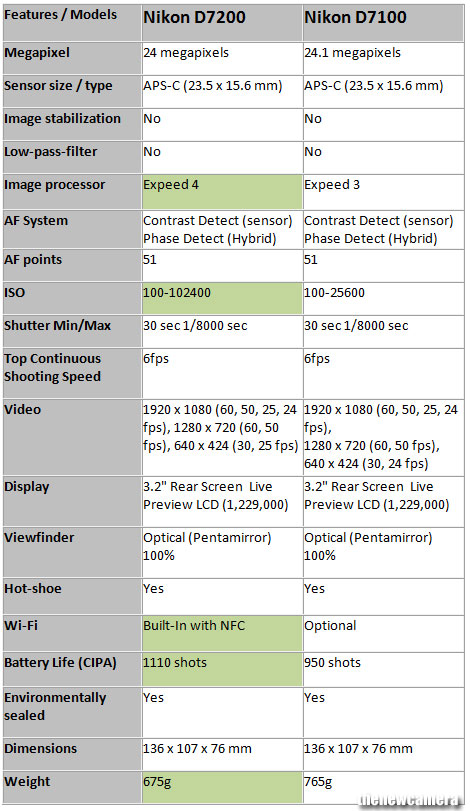 Sensor: Despite of having same resolution and sensor size and resolution, the Nikon D7200 sensor is new so we will see for sure some performance improvement in the camera. Sensor: Despite of having same resolution and sensor size and resolution, the Nikon D7200 sensor is new so we will see for sure some performance improvement in the camera.
Image processor: Just look at the table it’s clearly seen that Nikon D7200 uses Expeed 4 processor while its predecessor Nikon D7100 is operating by Expeed 3. The expeed 4 has a great help in consuming less power while capturing full HD (1080p) video at 50/60fps and decrease your anxiousness with improved contrast detection autofocus and live preview autofocus.
ISO: Thanks to the new sensor the Nikon D7200 can boost up its ISO range upto 102400, whereas the Nikon D7100 ISO is limited to 25600.
AF System: The AF system remains same and that’s the most disappointing point here.

WiFi– Wifi with NFC in Nikon D7200 plays a key role in sharing your images and videos with your some near and closest friend or someone by connecting with their android, iOs devices,tabs etc.
Battery life: The Nikon D7200 has been packed with a very powerful battery and that can apply power to the camera to take upto 1110 number of shots and on the other hand the battery of Nikon D7100 can let you to take 950 shots only.
Weight and dimensions: Dimensions are of same scale to both the cameras but again the Nikon D7200 is more comfortable to carry due to its lower mass as contrast with the Nikon D7100.
Verdict: Nikon D7200 have better core specification compared to Nikon D7100, the camera features new sensor, better image processor amd Built-in WiFi with NFC, hence we highly recommend you to go with Nikon D7200.
Buy Nikon D7200 from Amazon
By abhishek, on April 5th, 2015
 We’re going to clash the two cameras Nikon D7200 and Canon EOS 7D Mark II to check out their performance in different features. We’ll see how they prove right to each other and it’ll only be cleared when we go through all their specs thoroughly. We’re going to clash the two cameras Nikon D7200 and Canon EOS 7D Mark II to check out their performance in different features. We’ll see how they prove right to each other and it’ll only be cleared when we go through all their specs thoroughly.
Major Difference
Nikon D7200 vs. Canon EOS 7D Mark II Specification Comparison Table.
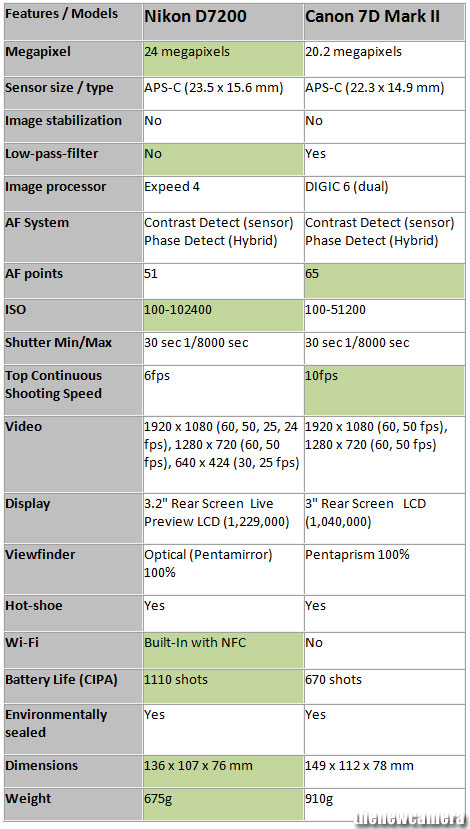
Megapixel: Though Nikon D7200 using 24MP of resolution as well as enjoying APS-C ( 23.3 x 15.6mm) and Nikon D7100 avails 20.2mp which is less than D7200 however Nikon D7200 produce more sharper and beautiful images.
Low pass filter: Nikon D7200 will have a good ability to capture the more details of the images along with edge to edge sharpness due to absence of no low pass filter and on the other side EOS 7D Mark II packed with low pass filter so it’ll miss to get the actual sharper images.
Auto Focus –
The Canon 7D Mark II AF system is more advance compared to the Nikon D7200 , the AF module of Canon 7D Mk II features 65 AF point all cross type and on the other hand the Nikon D7200 features 51 AF point, 15 cross-type. Both camera support AF detection sensitivity down to -3 EV.
Advance CMOS AF sensor inside the Canon 7D Mk II
The Canon 7D Mark II sensor features Dual pixel CMOS AF sensor technology and on the other hand the Nikon keep its believe on traditional contrast based detection system
The 7D Mark II 3rd generation Dual-pixel CMOS AF sensor that will give you blazing fast AF speed while you are using display or shooting video, on the other hand the Nikon D7200 features contrast based AF system that … so Nikon D7200 the AF speed is slow [compared to 7D Mk II] while a you are using display of recording a video file.
ISO: To freeze the subjects moving in a dark light more easy and comfortable with Nikon D7200 due to its iso range whose limits upto 104200 as a result of which it provides sharp and magnified images and on the other hand EOS 7D Mark II can’t be good as D7200 as it contains upto the range of 51200.

Shooting speed: Canon EOS 7D Mark II will be more loyal in capturing much of the actions of the subjects with 10 fps but the D7200 consumes 6fps.
WIFI: Without any physical stress Sharing and transferring images is much possible through wifi and NFC in D7200 however there’s no facilities of wifi in EOS 7D Mark II.
Battery life: You can take 1110 shots by using D7200 but 7D Mark II can let you to take 670 shots only.
High ISO Test — of Canon 7D Mark II and Nikon D7200
The first High ISO test of the Canon 7D Make II camera is done by the imagine resource, take a look at the high ISO test images below…
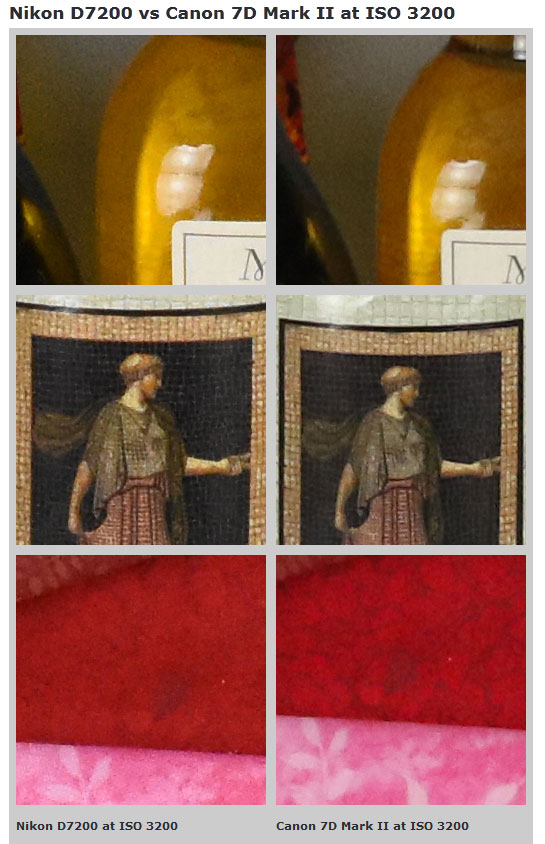
Image analysis – The Canon 7D Mark II images are bit soft compared to the Nikon D7200 camera, however the somehow Canon 7D Mark II sensor able to capture better red color pattern compared to Nikon D7200.
Verdict: The Canon 7D Mark II images are bit soft but it has advance AF system that includes 65 point AF system and Dual-pixel CMOS AF sensor and on the other hand the Nikon D7200 has weak AF system but tha images are bit sharp (thanks to the absence of low-pass filter). Personally I recommend you to go with Canon 7D Mark II, finally the choice is yours.
Buy Canon 7D Mark II body at Amazon || B&H
Buy Nikon D7200 from Amazon
By abhishek, on March 29th, 2015
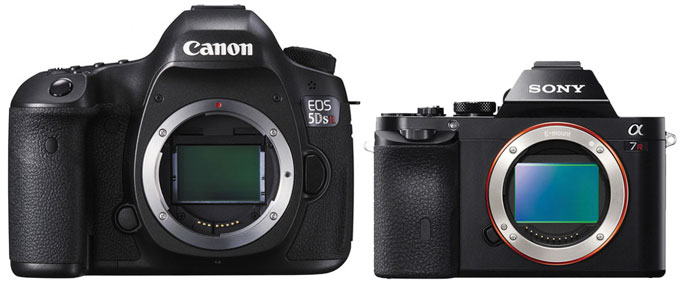 Both camera are megapixel monsters, the 5DS R announced shortly and its shipping will start soon on the other hand the Sony A7R is a year old camera. Both camera are megapixel monsters, the 5DS R announced shortly and its shipping will start soon on the other hand the Sony A7R is a year old camera.
Major Difference
Canon EOS 5DS R vs. Sony Alpha 7R Specification Comparison Table.
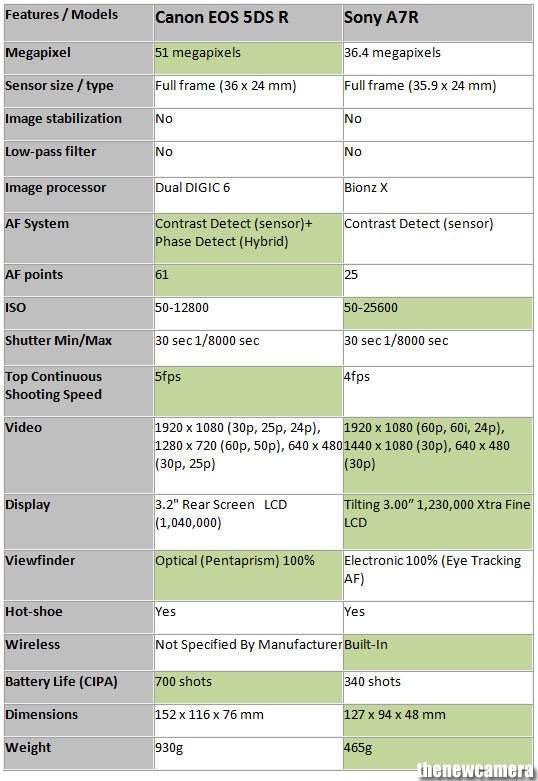
Sensor: The 5DS R camera features super high resolution fullframe sensor developed by Canon itself, the Sony A7R features 36MP sensor, so if you are a commercial photographer and need more resolution.. you must go with Canon 5DSR
AF system: The Canon 5DS R features advance AF system compared to the Sony A7R.
- The Canon 5DSR features Phase+Contrast based AF system, while you are using the viewfinder the Phase AF system is active and when using the display for still shots or video recording , contrast detect AF system is active. Now if we talk about the phase AF module of Canon 5DS R, it is a 61-point High Density Reticular AF system with up to 41 cross-type AF points, the phase AF system of Canon is blazing fast and acquire AF to quick despite of lighting condition.
- The Sony A7R features contrast detect AF system, hence without doubt the Sony A7R contrast detect system is bit weak compared to Canon 5DS R camera.
ISO range: The ISO range of the Canon 5DS R camera is limited to 12800 due to intense resolution, the Sony can move forward to one-stop more .. that’s upto 25600, so Sony will sure give you bit better low light images with less details compared to 5DS R (due to difference in resolution)
Top Continuous shooting speed: The Dual digic 6 image processor of the Canon 5DS R is tooo fast compared to the Sony Bionz X R image processor, the 5DS Can record 50MP of still images @ 5 fps per second and Sony A7R can record 36MP of images at 4fps per second.
Display: The display screen of Sony A7R has 3.0″ Tiltable TFT LCD with 1,229K-Dots whereas Canon EOS 5DS R has 3.2″ 1,040K-Dot ClearView II LCD Monitor. The 5DS R camera features better display unit compared to A7 R.
Battery life: By charging battery for single time you shoot 700 images through Canon EOS 5DS R which is not possible in case of Sony A7R, since it is limited to 340 images.
Wireless: The in built WiFi and NFC feature only exists in Sony A7R camera but you cannot enjoy this these features in Canon EOS 5DS R. By help of wireless connectivity you can easily attach your camera with smartphone or transfer you image to smart devices wirelessly.
Price difference: The Canon 5DS R camera will cost you approx $3,899.00 and Sony A7R will cost your approx $2,298.00, you will save approx $1600 is you buy Sony A7R.
Weight: The weight of Sony A7R is light weight as compared to Canon EOS 5DS R. If you see in above table the weight of Sony A7R is only 465 gram whereas weight of Canon EOS 5DS R has 930 gram. So it is very handy to carry Sony A7R in your hand.
Verdict: Canon 5DS R features more resolution, advance phase detect AF system and fast continuous shooting speed and bunch of high R quality lenses to choose from, we highly recommend you to buy Canon 5DS R camera.
Sony A7r from Amazon | B&H || Buy Canon 5DS R from Amazon | B&H
|
KEEP THIS BLOG ALIVE - Support New Camera Buy Canon Lenses, Buy Music CD or Digital Camera at amazon it helps this site, and you do not pay anything extra, it is just a way to help support this site.

|
 The FZ300 is recently announced by Panasonic, the camera features advance core specification but the only problem is the small sensor inside it, on the other hand Sony RX10 II features large 1″ sensor…. Take a look at the specification comparison review between the Sony RX10 II and FZ300 camera,
The FZ300 is recently announced by Panasonic, the camera features advance core specification but the only problem is the small sensor inside it, on the other hand Sony RX10 II features large 1″ sensor…. Take a look at the specification comparison review between the Sony RX10 II and FZ300 camera, Hence the sensor of RX10 II is larger and superior to FZ300. The large sensor inside the RX10 II definitely improves the clarity and image as well its performance in low-light condition. Sony RX10 II has two stop more ISO compare to FZ300 , which makes it more sensitive to low-light environment and hence it captures correctly exposed image even at low-light condition when compared to FZ300.
Hence the sensor of RX10 II is larger and superior to FZ300. The large sensor inside the RX10 II definitely improves the clarity and image as well its performance in low-light condition. Sony RX10 II has two stop more ISO compare to FZ300 , which makes it more sensitive to low-light environment and hence it captures correctly exposed image even at low-light condition when compared to FZ300.






















